-
Welcome back Guest! Did you know you can mentor other members here at H-M? If not, please check out our Relaunch of Hobby Machinist Mentoring Program!
You are using an out of date browser. It may not display this or other websites correctly.
You should upgrade or use an alternative browser.
You should upgrade or use an alternative browser.
Anvil Stand Question
- Thread starter bcall2043
- Start date
- Joined
- Apr 24, 2013
- Messages
- 167
We used to use white oak for building flat bottom clam boats on Long Island (NY), sharpies and garveys. White oak for chines and frames and plywood sheathing with fiber glass layers on top of the plywood. Some of those work boats built in the 70's & 80's are still in service but most have been replaced with v-bottom fiberglas skiffs.
Note the problem with oak for the anvil stump is splitting not rot Elm rots but won't split locust is a good anvil stump that won't rot and is less prone to splitting. Locust is also good in boat building, tool handles and of coarse fence posts.
Bob
Note the problem with oak for the anvil stump is splitting not rot Elm rots but won't split locust is a good anvil stump that won't rot and is less prone to splitting. Locust is also good in boat building, tool handles and of coarse fence posts.
Bob
- Joined
- Oct 6, 2010
- Messages
- 699
Not really. I have what I have heard is a small rivet forge that needs some work. Thinking about repairing it or build one. I would like to be able to do some forge work at home. I can take classes in nearby Murfreesboro, TN...................do you have a forge?
bob
........... Note the problem with oak for the anvil stump is splitting not rot Elm rots but won't split locust is a good anvil stump that won't rot and is less prone to splitting. Locust is also good in boat building, tool handles and of coarse fence posts.
Bob
Here’s a quick update on the project.
The above is an interesting discussion on the types of wood to use for a project like this. I just lucked into the piece I have due to storm damage at a neighbors. The piece was just a couple of weeks old and starting to show signs of cracking. I used a liquid waxy product to seal the ends to slow the drying process. Hopefully this will help with the cracking. I also wire brushed the algae off the bark and applied an oil based stain produce all over. Hopefully this will slow drying even more. It also made the wood look better in my opinion. The piece of wood is drying in the shop for the time being. Maybe the crack will not open up so much the anvil falls in the crack!:rofl:
I am thinking of using some chain pieces that I scored at the scrape yard to hold the anvil down.
I will post more photos as the project nears completion.
Benny
The Orphanage Never Closes
- Joined
- Jul 26, 2011
- Messages
- 4,142
White oak has that shaggy bark. Red oak doesn't look like that. I am wondering if that is a steel anvil? Does a ball bearing dropped on it bounce almost as high as it was dropped? Does it ring? If neither,it may be a cast iron anvil which will not stand hammer blows too well. If it rings,the usual way to stop it ringing,and prevent hearing loss,is to chain it down tightly to the stump. Drive a couple of large rings with shanks snugly into holes bored into the stump. Then,use two other such rings with bolts to draw the chains down tight.
Some anvils will ring anyway. Another cure is to wrap an inner tube snugly around the waist of the anvil. My anvil is a solid,hard steel one,and the chain method works. Make no mistake,a ringing anvil is VERY bad for your hearing.
P.S.:I was Master Musical Instrument Maker in Colonial Williamsburg from 21970-86. Then,they begged me into becoming Master Tool and Instrument Maker to supply all there Historic Area craftsmen with authentic tools because there was no way to get them without masking them in house.
Some anvils will ring anyway. Another cure is to wrap an inner tube snugly around the waist of the anvil. My anvil is a solid,hard steel one,and the chain method works. Make no mistake,a ringing anvil is VERY bad for your hearing.
P.S.:I was Master Musical Instrument Maker in Colonial Williamsburg from 21970-86. Then,they begged me into becoming Master Tool and Instrument Maker to supply all there Historic Area craftsmen with authentic tools because there was no way to get them without masking them in house.
Last edited:
- Joined
- Jul 26, 2011
- Messages
- 4,142
I think I've heard that. How big a magnet does it take? I'd think that if you stuck a large magnet on it,every bit of steel crud would stick to the anvil,which could be inconvenient if you want to keep the top clean.
That anvil looks like a Chinese cast iron one is why I asked what it's made of. They make them with the rear top tapered like that. Can you easily file it on the top or the horn? A good anvil will not file much AT ALL. I can see there is no steel laminated onto the top,but they can be all steel like mine.
Below there are pictures of 2 18th. C. anvils that I made the patterns for for the Anderson Blacksmith's Shop in Williamsburg. The one shown on the stump is the first type. I made that pattern in the 70's and they have several in their shop. The one on the floor is an 5 legged earlier type with a curiously small horn. It hasn't yet had the top ground. They got the hardie hole too large,too. These anvils were cast from 4140 steel. Thay are both 300# anvils. They would have been forged from wrought iron in the 18th. C.,with steel tops welded on. These days,there are no anvil makers with facilities to do that. It takes enormous heat,cranes,and a waterfall to quench them.
Also,there its a beak,or bic iron I made from solid 01 steel. There is a picture of my own anvil with the top polished. We use it mostly for silver work as my wife has a jewelry business I help her with. My polished beak iron is in the hardie hole. This anvil is a rare type with the hardie hole at the front end. It is called a "Soho engine forger's anvil". I have no idea why they wanted the hardie hole at the front end. The yellow can is my last can of Kasenit. For deeper hardening,though,we used aquarium charcoal(which is full of holes),and an enclosed iron container. Aquarium charcoal used to be made of monkey bones from laboratory monkeys,though they don't want that to be much known!! I'm not sure if that's still the case or not.
You can make out 2 small little hammers in the leather strip that I made too. They have a polished fire blue finish. I didn't make the little ball pein between them. The 1/2 round log showing black is African blackwood,which is actually a type of rosewood just as black as ebony when oiled. In the 18th. And 19th.C's,it was preferred over ebony for decorative turning as it isn't abrasive like ebony.
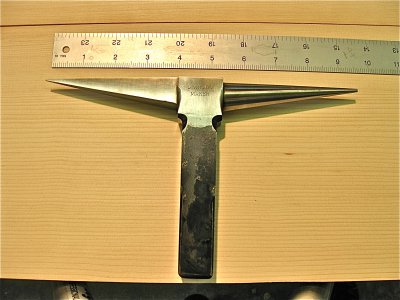
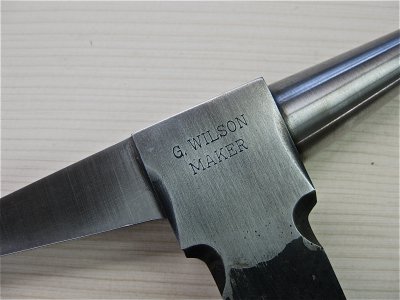
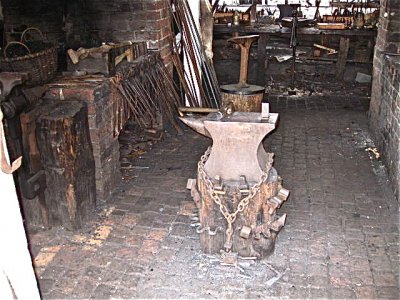
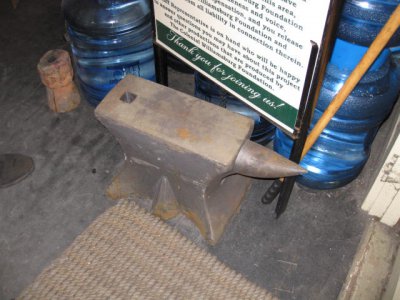
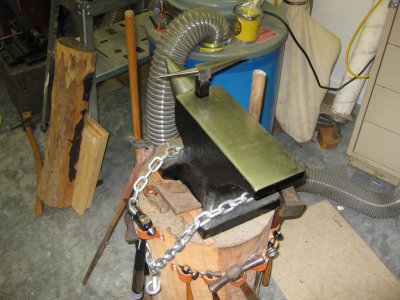
That anvil looks like a Chinese cast iron one is why I asked what it's made of. They make them with the rear top tapered like that. Can you easily file it on the top or the horn? A good anvil will not file much AT ALL. I can see there is no steel laminated onto the top,but they can be all steel like mine.
Below there are pictures of 2 18th. C. anvils that I made the patterns for for the Anderson Blacksmith's Shop in Williamsburg. The one shown on the stump is the first type. I made that pattern in the 70's and they have several in their shop. The one on the floor is an 5 legged earlier type with a curiously small horn. It hasn't yet had the top ground. They got the hardie hole too large,too. These anvils were cast from 4140 steel. Thay are both 300# anvils. They would have been forged from wrought iron in the 18th. C.,with steel tops welded on. These days,there are no anvil makers with facilities to do that. It takes enormous heat,cranes,and a waterfall to quench them.
Also,there its a beak,or bic iron I made from solid 01 steel. There is a picture of my own anvil with the top polished. We use it mostly for silver work as my wife has a jewelry business I help her with. My polished beak iron is in the hardie hole. This anvil is a rare type with the hardie hole at the front end. It is called a "Soho engine forger's anvil". I have no idea why they wanted the hardie hole at the front end. The yellow can is my last can of Kasenit. For deeper hardening,though,we used aquarium charcoal(which is full of holes),and an enclosed iron container. Aquarium charcoal used to be made of monkey bones from laboratory monkeys,though they don't want that to be much known!! I'm not sure if that's still the case or not.
You can make out 2 small little hammers in the leather strip that I made too. They have a polished fire blue finish. I didn't make the little ball pein between them. The 1/2 round log showing black is African blackwood,which is actually a type of rosewood just as black as ebony when oiled. In the 18th. And 19th.C's,it was preferred over ebony for decorative turning as it isn't abrasive like ebony.





- Joined
- Oct 6, 2010
- Messages
- 699
White oak has that shaggy bark. Red oak doesn't look like that. I am wondering if that is a steel anvil? Does a ball bearing dropped on it bounce almost as high as it was dropped? .............
George,
Thanks for your replies. I always enjoy reading your post. You have a lot of experience in the historical areas of our hobby. I am just learning and have wanted to try a little forging for some time now. I have collected some tongs shown in the photo below, the rivet forge, and most recently the anvil.
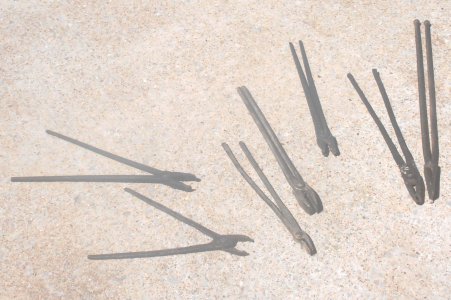
In answer to your questions, I suspect the anvil I have is a cheap one. Not sure beyond that. I got it off Craigslist. The only markings on it is the weight cast on the sides. Unless I get into the forging thing big time it should do better than nothing for me. Thanks for the bouncing ball idea. I will try that when I next drag the anvil out and mount it on the stump.
Off Topic:
I read a post somewhere about machining the shaper/slotter mounting "eye" on the ram of Bridgeport clone. I swear the post was by you but I have not been able to find the post again. Does that ring a bell with you? If so I would like to "pick you brain" as I have the same problem to correct on my vertical mill.
Thanks, Benny

- Joined
- Jul 26, 2011
- Messages
- 4,142
I did have to thin the shaper mounting rear end flat area of my Bridgeport CLONE,because it was not a real Bridgy. Took several thou off by mounting a carbide lathe tool upright in the vise.n Then,I ran the table back and forth,adjusting it sideways a little each cut. It came out very accurate. I have always been afraid of busting the flat area off of the mill if the shaper was too powerful,so I'm careful. A few times,I've stalled out the belt,and that's fine. Better than too much power. I'd never get over it if I broke the ram!!
The shaper attachment came with a 1/2 HP motor,3 phase. I was VERY LUCKY to have a 1/3 HP motor,1 phase, that would perfectly fit the mounting. I don't know how thick real Bridgies are at their ram,but I like to be careful. I've been absolutely pleased with my Taiwan mill,and just haven't bothered to change it,even when real Bridgies have become available. I bought it in 1986,and it is still almost like new,except for a few oil stains.
The shaper attachment came with a 1/2 HP motor,3 phase. I was VERY LUCKY to have a 1/3 HP motor,1 phase, that would perfectly fit the mounting. I don't know how thick real Bridgies are at their ram,but I like to be careful. I've been absolutely pleased with my Taiwan mill,and just haven't bothered to change it,even when real Bridgies have become available. I bought it in 1986,and it is still almost like new,except for a few oil stains.
- Joined
- Oct 6, 2010
- Messages
- 699
I did have to thin the shaper mounting rear end flat area .......... Took several thou off by mounting a carbide lathe tool upright in the vise.n Then,I ran the table back and forth,adjusting it sideways a little each cut. ............ I've been absolutely pleased with my Taiwan mill.......................
George,
Thanks for the quick reply. I had seen your post somewhere on the web and wanted to review your methods.
I have a Taiwan built 1977 Hartford that was purchased by an employee of a company up in Mass. at a early age (the machine age not his). He said it was a lab machine and it seems to have seen very light duty, very tight machine. I tried to mount a Bridgeport shaper head but ran into the same over size ram-flat condition you did. I had thought about making a special tool to mount on the ram ways but like your idea better. I already have the tooling for your method.
I like my clone also. It is much tighter than what you find in most of the used real Bridgeport's for sale. When I bought it I asked one of the maintenance guys where I was working up in New Hampshire about the mill. He said it was a good enough clone that the parts were interchangeable. I not sure if this is totally true but when forum member Charley Davidson bought his Bridgeport he was missing a part and we took the one off my machine and put it on his until we could make a replacement part.
Thanks again,
Benny

